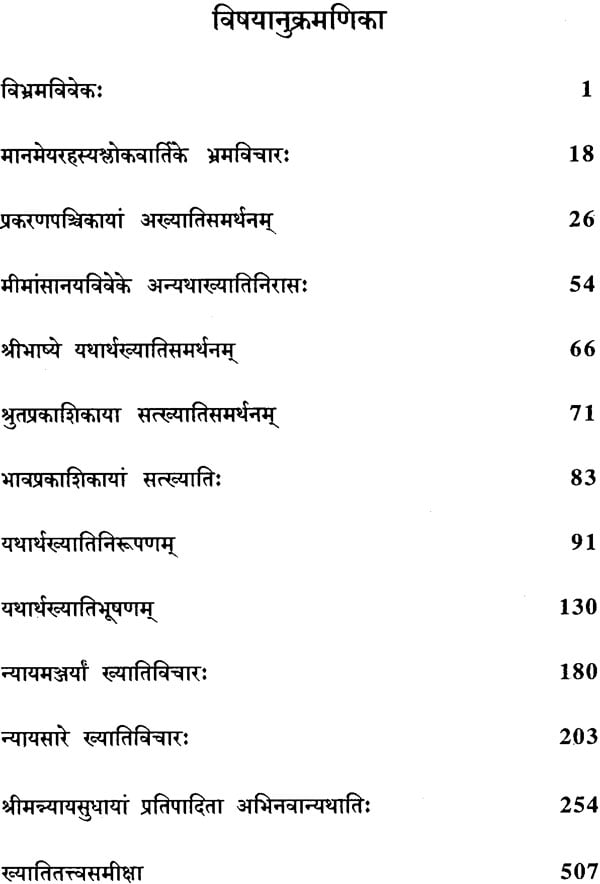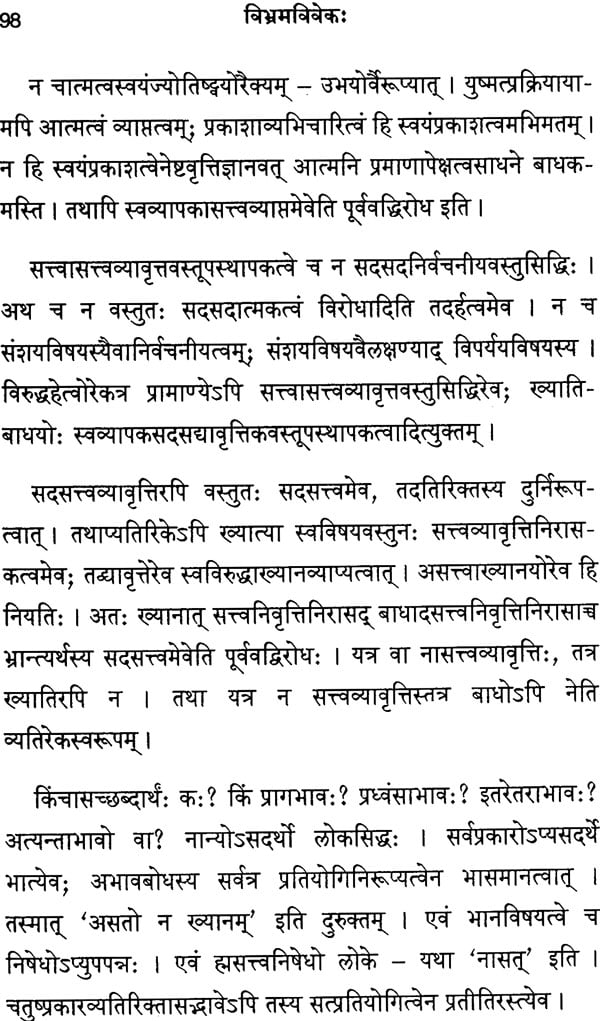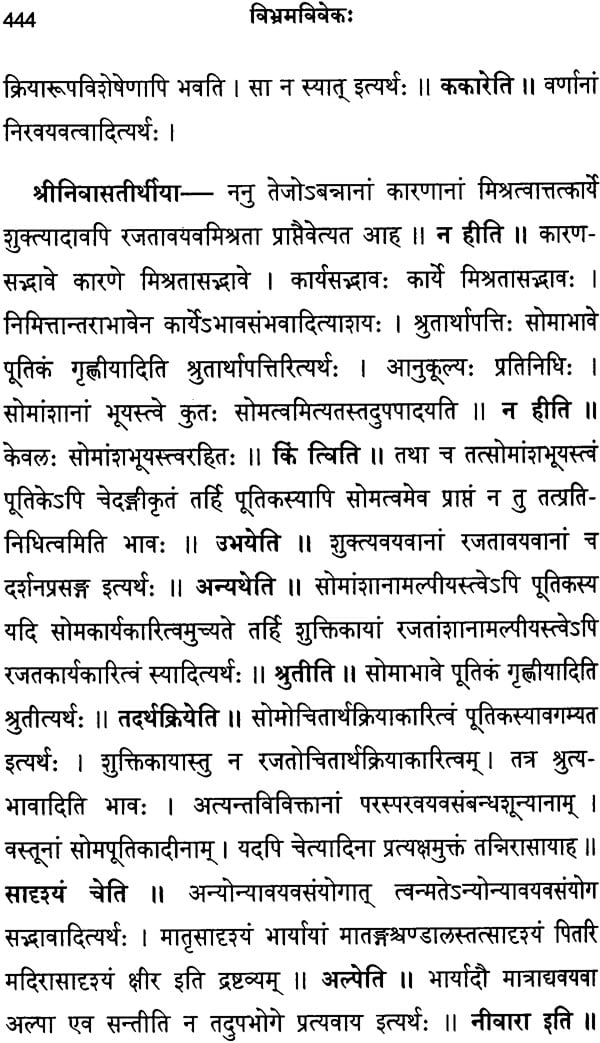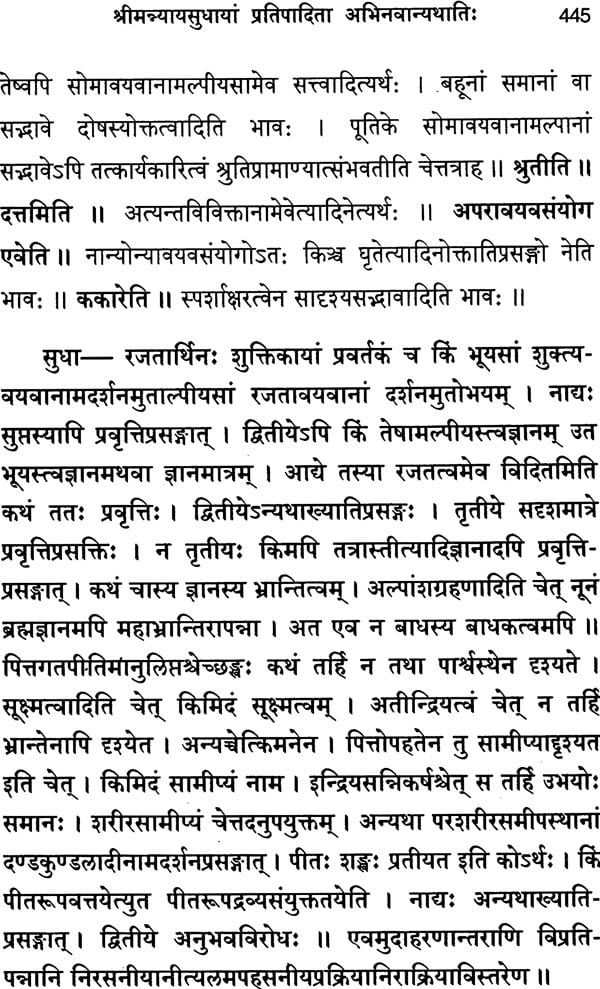
विभ्रमविवेकः Vibhrama Viveka of Sri Mandna Misra
Book Specification
| Item Code: | NZK387 |
| Author: | Prof. K. T. Pandurangi |
| Publisher: | Dvaita Vedanta Studies and Research Foundation |
| Language: | Sanskrit Only |
| Edition: | 2008 |
| Pages: | 656 |
| Cover: | Paperback |
| Other Details | 8.5 inch X 5.5 inch |
| Weight | 870 gm |
Book Description
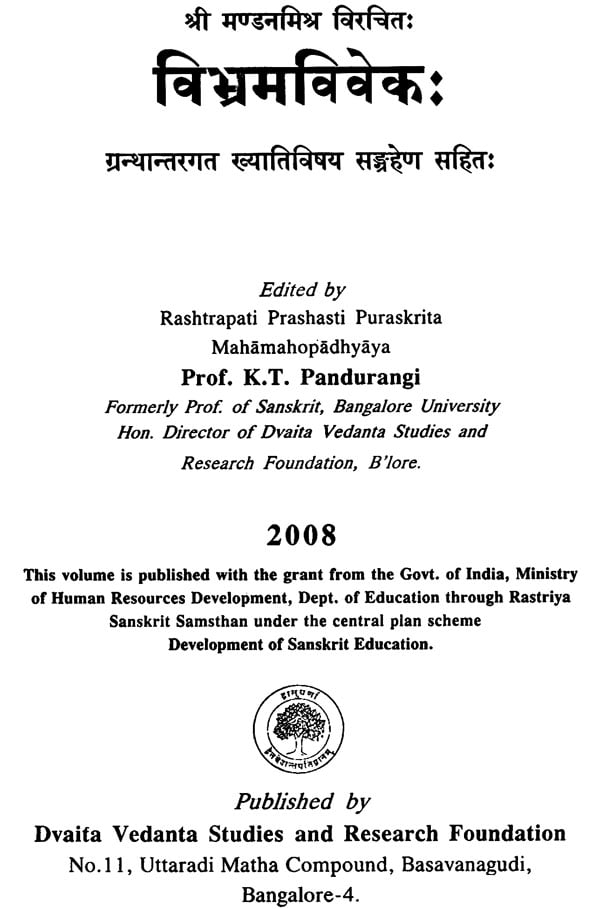
In Indian epistemology the theories of perceptual error have played an important role. There are five dimensions of these theories. (i) Optical(ii) psychological (iii) epistemological (iv) logical and (v) Metaphysical.
The process of error starts at optical level. The psychological level adds to it. It takes epistemological shape. These three aspects have to be taken into account while analysing the nature of error. The analysis has to satisfy the logical requirements. Different schools of Indian Philosophy have different metaphysical view. They have worked out their theory of perceptual error within the framework of their metaphysical system. Consequently every school has its own theory of error. These theories are known as Khyati theories. These could be broadly grouped into two (i) Idealist and (ii) Realist. Atmakhyati and Asatkhyati theories of Vijnanavadin and Madhyamika come under the first group. Within the second group of Realists, there are two groups viz Anyatha khyati and Yathcirtha khyati. The Anyathakhyati of Nyayavaisesikas, Viparitakhyati of Bhattas and Abhinava anyatha khyati of Dvaita Vedanta come under Anyatha khyati group. The Akhyati theory of Prabhakaras, Yatharthakhyati of Ramanuja and Satkhyati of Samkhyas come under Yatharthakhyati group.
The Anirvachaniya khyati of Advaita is a class by itself. It is based on the Sad-asad-vilaksana concept of advaita metaphysics and epistemology.
Almost all schools of Indian Philosophy discuss the khyati theories in their major works and defend their respective theory. Mandana Mishra has written a separate treatis viz vibhrama viveka and has discussed five khyati theories.
Vibrama Viveka of Mandana Misra analyses perceptual errors. This is technically known as "Khyati." At the commencement of his work, he mentions five theories of Khyati and examines them in detail. He criticizes "Akhyati" theory of Prabhakaras and supports the "Viparita Khyati" theory of Bhatta Mimamsakas. He also mentions "Anirvachaniya Khyati" of Advaitha. ‘Khyati’ theory is a very important topic in Indian Epistemology. Every school of philosophy has formulated its own Khyati theory. In this volume, we have published the small work on "Khyati" namely. 'Vibhrama Viveka" by Mandana Misra, We have also collected the exposition of different Khyati theories in different works and added in this volume, with a view to give a complete picture of the "Khyatt" theories so for developed in Indian Epistemology. We hope this will be a very useful reference work on Khyati theories.
In Indian epistemology the theories of perceptual error have played an important role. There are five dimensions of these theories. (i) Optical (ii) psychological (iii) epistemological (iv) logical and (v) Metaphysical.
The process of error starts at optical level. The psychological level adds to it. It takes epistemological shape. These three aspects have to be taken into account while analysing the nature of error. The analysis has to satisfy the logical requirements. Different schools of Indian Philosophy have different metaphysical view. They have worked out their theory of perceptual error within the framework of their metaphysical system. Consequently every school has its own theory of error. These theories are known as khyati theories. These could be broadly grouped into two (i) Idealist and (ii) Realist. Atmakhyati and Asatkhyati theories of Vijanavadin and Madhyamika come under the first group. Within the second group of Realists, there are two groups viz Anyatha Khyati and Yathartha khyati. The Anyathakhyati of Nyayavaisesikas, Viparitakhyati of Bhattas an Abhinava anyatha khyati of Dvaita Vedanta come under Anyatha khyati group. The Akhyati theory of Prabhakaras, Yatharthakhyati of Ramanuja and Satkhyati of Samkhyas come under Yatharthakhyati group.
The Anirvachaniya khyati of Advaita is a class by itself. It is based on the Sad-asad-vilaksana concept of advaita metaphysics and epistemology.
The theories of Atmakhyati and Asatkhyati were utilised by Buddhists to explain their metaphysical view. Advaita utilised Anirvachaniyakhyati to support its Sad-asad vilaksana view.
Almost all schools of Indian Philosophy discuss the khyati theories in their major works and defend their respective theory. Mandana Mishra has written a separate treatis viz vibhrarna viveka and has discussed five khyati theories.
He particularly criticises the Akhyati theory of Prabhakaras and supports Viparitakhyati theory of Bhattas. He does mention Anirvachanfya khyati.
Sri Jayatirtha discusses five prominent khyati theories in Nyayasudha and establishes Abhinava anyathakhyati theory of Dvaita Vedanta. Recently, Vepattur Subrahmanya Shastry has written a special work on this topic viz khyati tattva samiksa. Presenting Vyakarana view is a special point of this work. He reviews Dvaita and Visistadvaita views.
His criticism of Visistadvaita view is answered by Sri Ramanuja tatacharya in his work Yatharthakhyati bhusana. Some modern works on this topic have also appeared in English. Among these ‘The theory of error in Indian Philosophy by Dr. Bijayananda Kar 'Perceptual error- the Indian theories by Dr. Srinivasa Rao, The critique of the theories of Viparyaya by Nani Lal Sen deserve special mention. These modern works are not affiliated to any particular school.
In spite of a large number of works on this subject and continued debate among philosophers, this problem still remains vexed problem. Prof. Kuppuswamy Shastry has given a good analysis of the five theories of error in his introduction to Vibhrama viveka. He has made an interesting remark. All the theories of Khyati involve a negative element. In Asatkhyati the negative element is obvious. In Atmakhyati the external object is absent. In Anyathakhyati the negative element is found in respect of sansarga or in presenting one object as another which is not present. He says even in Akhyati of Prabhakara the viveka agraha is a negative element. It is difficult to agree with this remark since the viveka agraha is not a content of the two cognitions. He also remarks that in the anirvachaniyakhyati no negative element is involved. It is difficult to agree with this remark also since the Pratibhasika sattaka rajata is supper imposed on vyavaharika sattaka sukti and for the sake of Pravrtti it is taken as Vyavaharika. It is something like a tadatmyaropa of Nyayavaisesika and does involve negative element.
This problem needs full investigation. It also needs a comparative study with modern scientific view and western philosopher's view. Error is a distorted cognition. To determine the nature of error one has to investigate as to at what level the distortion has taken place.
i) Is it a distortion at ontological level.
ii) Is it a distortion at psychological level.
iii) Is it a distortion at epistemological level.
iv) Do these levels separately cause distortion or more than one level is involved in the distortion of the cognition.
These are the questions that have to be deeply examined.
a) Broadly speaking the Nyayavaisesikas go by the distortion at ontological level, that is to say one entity is taken as another. However, Sanskara or Jnanalaksana pratyasatti are of psychological nature. These assist the distortion.
b) Prabhakaras go by the distortion at epistemological level, that is to say the difference between the two cognitions is not realised.
c) Vijnanavadins go by the distortion purely at psychological level. These approaches have to be sorted out to determine the nature of error.
The Anyathakhyati theories in Indian Philosophy
Among the Khyati theories the anyathakhyati of Nyaya has a central position. It is discussed by all schools while presenting their respective theories. According to this theory, in the stock example of shell-silver error the shell is cognised as silver. The shell is present before the observer. His eye is in contact with it. However, he does not cognise its special characteristic suktitva but cognises it in a general way as a shining object. He also cognises the features that are similar to shell and silver. As he had cognised the silver earlier elsewhere, his mind brings in the silver by way of jnana laksana pratyasatti, that is say, his previous knowledge of silver itself serves as a contact to bring in the silver into the fold of his cognition. Both shell and silver are true objects. But the characteristic of rajatatva is not found in the shell. However, this characteristic rajatatva is presented as characterising Idam i.e. suktt, in the cognition while the jenuine characteristic of sukti i.e. suktitva is not presented. Consquently he cognises shell as silver. This is anyatha khyati. Cognising an entity as another Cognitions of both shell and silver are of the nature of perception according to Nyaya.
These are not two cognitions as in Prabhakara's theory. But the two objects are provided in the cognition by two different relations. The Idam i.e. shell is provided by the laukika sannikarsa i.e. normal contact of the eye with the shell as idam and the other i.e. rajata or rajatatva by alaukika sannikarsa i.e. extraodinary contact known as jnanalaksana pratyasatti. These two viz Idam and rajatatva that are really not associated with each other are presented as associated with each other. This makes the cognition erroneous. The important point to be noted here that the two objects of the cognition are really present outside the cognition. These are cognised in the cognition.
